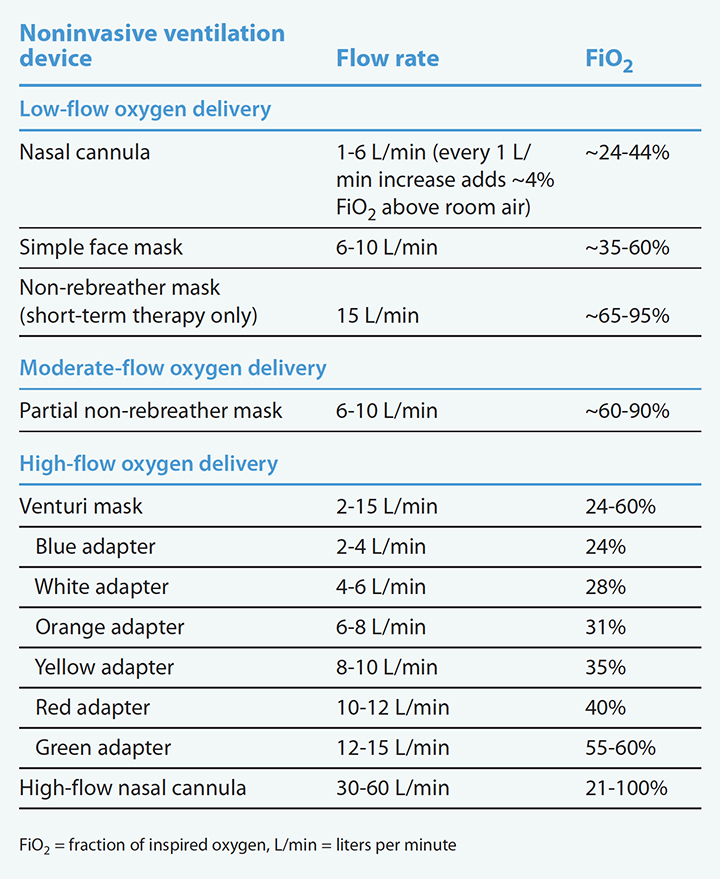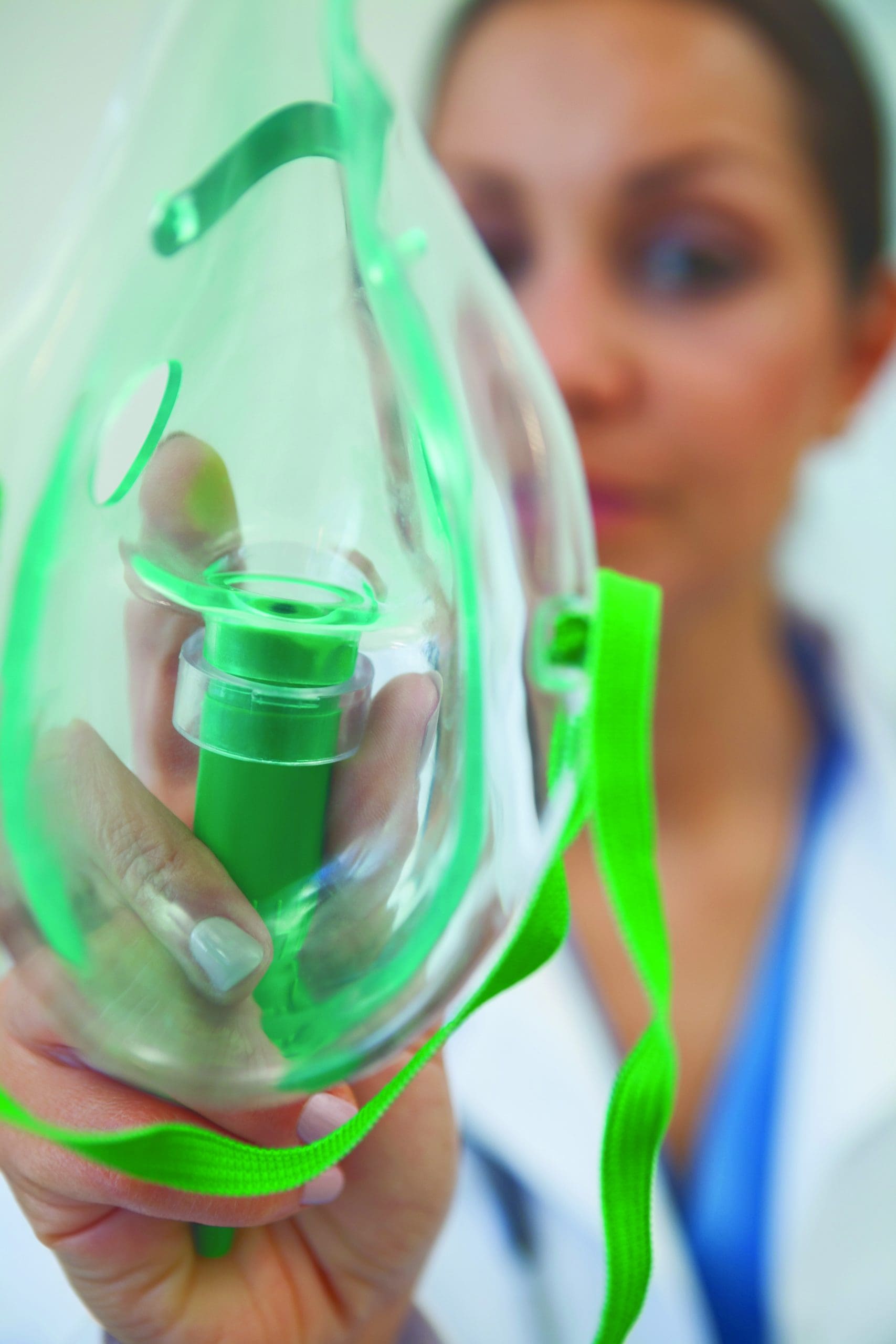Knowing the benefits and drawbacks of the options helps drive patient-centered care.
Takeaways:
- Traditionally, oxygen delivery systems are categorized as low, moderate, and high flow.
- Understanding oxygen delivery systems to include the various devices and interfaces is essential to improving patient outcomes
Prompt delivery of supplemental oxygen that’s tailored to the needs of the individual is essential to decrease morbidity and mortality and improve patient outcomes. Knowledgeable and experienced bedside nurses are vital for providing safe, effective oxygen therapy.
Oxygen can be delivered invasively or noninvasively. Noninvasive ventilation (NIV) delivers ventilatory support without an artificial airway (endotracheal or tracheostomy tube) to patients who can breathe spontaneously. NIV benefits include keeping the upper airway intact, preserving natural airway defenses, self-expectorating secretions, and allowing the patient to eat, drink, and communicate verbally.
This article outlines the pathophysiology of oxygenation; describes the clinical indications, advantages, and limitations of NIV; explains the modes of oxygen delivery, flow rates, and interfaces; and details the nursing care necessary to maximize success. (See Oxygenation basics.)
Oxygenation basics


Oxygenation requires ventilation and respiration.
- Ventilation—the movement of air in and out of the lungs—is controlled by the neurologic and musculoskeletal systems.
- Respiration—oxygen and carbon dioxide exchange in the lungs— is controlled by the pulmonary and cardiovascular systems.
Common clinical signs of inadequate oxygenation and indications for oxygen therapy include
- accessory muscle use
- confusion
- cyanosis
- dyspnea
- hemodynamic instability
- hypoxemia
- hypoxia
- tachycardia
- tachypnea.
NIV options
The type of NIV chosen is based on the patient’s required oxygen dose, which is determined by the fraction of inspired oxygen (FiO2) and the rate of oxygen flow (gas flow, liters/minute [L/min]). Other decision factors include the patient’s tolerance for the device and interface (for example, nasal cannula or mask). Interface options are governed by organizational resources and policies, the required amount of FiO2, and the service location (for example, intensive care, progressive care, or medical/surgical unit).
Oxygen delivery devices are categorized as low-, moderate-, and high-flow. (See Delivering oxygen.)
Delivering oxygen
Noninvasive ventilation is administered via low-, moderate-, and high-flow devices.


Low-flow
Low-flow oxygen delivery systems include nasal cannulas, simple face masks, and non-rebreather (NRB) masks. Flow rates for these interfaces range between 1 to 15 L/min.
Nasal cannulas. Nasal cannulas are the most common type of low-flow oxygen delivery system. They’re an excellent choice for patients with stable respiratory patterns who require low percentages of oxygen. Because no external oxygen reservoir is used, the upper airway acts as the reservoir and works best if the patient breathes through their nose.
Nasal cannula advantages include ease of use and comfort. In addition, they allow the patient to talk, drink, eat, stay mobile, and self-expectorate. Oropharynx suctioning can be performed without removing the device. To decrease nasal dryness, humidification can be used in flow rates greater than 3 L/min.
Nasal cannulas are ineffective in patients with nasal obstructions, and they’re contraindicated in patients with nasal trauma or surgery.
Face masks. Simple face masks are used in patients who require short-term, higher oxygen concentration, such as FiO2 35% to 60%. To prevent exhaled carbon dioxide accumulation within the mask, the flow rate must be set at more than 6 L/min. Face masks don’t have a reservoir bag; instead, they have holes that allow room air to enter the mask and carbon dioxide to be exhaled. The holes also reduce the risk of suffocation if the oxygen supply is disconnected.
The oxygen concentration delivered via simple face mask varies by the amount of room air that mixes with the delivered oxygen when the patient inhales. Because of this variability, these devices aren’t commonly used in acute-care settings; they’re more typically used in pre-hospital settings, such as when paramedics respond to a home emergency.
NRB masks. NRB masks have an attached reservoir bag (600 to 1,000 mL capacity) that allows for a higher concentration of oxygen delivery. Before placing the mask on the patient, the reservoir bag must be inflated to more than two-thirds full. An estimated one-third of the air from the reservoir bag is depleted as the patient inhales and is then replaced by the flow from the oxygen supply. The one-way valve allows exhaled air to escape and prevents room air inhalation.
These low-flow masks typically are used in patients with smoke inhalation, carbon monoxide poisoning, and chronic airway diseases and those who are severely hypoxic but are ventilating well. They shouldn’t be used in patients with facial trauma or who are claustrophobic, and caution should be used in patients who are at risk for carbon dioxide retention, such as those with chronic obstructive pulmonary disease. NRB masks, which are intended for short-term use only, prevent patients from eating, drinking, and self-expectorating.
Moderate-flow
Moderate-flow oxygen devices include the partial rebreather mask (PRB). Their flow rates range from 6 to 10 L/min and provide oxygen concentrations between 60% and 90%.
PRB masks. PRB masks are similar to NRB masks but have one two-way valve. During use, the first third of the patient’s exhaled volume fills the reservoir bag, so that with the next breath, the exhaled gas (which is in the reservoir bag) and the fresh gas are inhaled. The reservoir bag must remain inflated throughout the entire ventilatory cycle so the appropriate FiO2 is delivered and adequate carbon dioxide escapes. PRB masks typically are used in pre-hospital settings and during transport because the rebreathing property of the mask allows for oxygen conservation.
High-flow
High-flow oxygen delivery provides constant FiO2 at flow rates that meet or exceed the patient’s peak inspiratory demands and prevents ambient air entrainment and FiO2 dilution. High-flow delivery systems include Venturi masks and high-flow nasal cannula (HFNC). Entrainment is based on Bernoulli’s principle, which explains what occurs when a stream of gas is pushed through a narrow opening. An air-entrainment system is powered by oxygen (the gas source) with jet orifices on the inside of the device and open ports on the side, which entrain (pull in) air to add to the flow of oxygen. When the oxygen passes through the narrow opening, it creates negative pressure, which causes ambient air to mix with oxygen flow. The smaller the hole, the more pressure is created, the less ambient air is entrained, and the higher the FiO2. Conversely, the bigger the port opening, the more ambient air is entrained, and the lower the FiO2.
Venturi masks. Venturi masks control the ratio of entrained ambient air in proportion to the amount of oxygen delivered at a high velocity through a jet adaptor to allow for accurate FiO2. Exhalation ports on the mask allow carbon dioxide to escape and provide total inspiratory flow at a specified FiO2. The Venturi mask kit comes with color-coded adapters that correspond to a desired FiO2 or have a rotating attachment to control the air entrainment window. Limitations of the Venturi mask are similar to NRB masks—they prevent patients from eating, drinking, and self-expectorating.
HFNCs. HFNCs are similar to nasal cannulas, but the nasal prongs are wider and are attached to a heated corrugated circuit to avoid heat loss and condensation. The basic components of an HFNC include a flow generator, an air-oxygen blender, and a heated humidifier.
HFNCs wash out anatomic dead space and overcome resistance against expiratory flow, creating positive pressure in the nasopharynx. Constant high-flow oxygen delivery allows for steady FiO2 delivery and decreases oxygen dilution. The flow generator provides gas flow rates up to 60 L/min. The air-oxygen blender achieves FiO2 escalation from 21% to 100%, regardless of flow rate. The heated humidifier saturates the gas mixture at 87.8° F to 98.6° F (31° C to 37° C). These components allow for an independent flow rate and FiO2 titration to improve functional residual capacity, mucociliary clearance of secretions, and decreased work of breathing.
Five physiologic mechanisms are believed to be responsible for HFNC efficacy: physiological dead-space washout of waste gases, including carbon dioxide; decreased respiratory rate; positive end-expiratory pressure; increased tidal volume; and increased end-expiratory volume. HFNCs reduce nasopharyngeal airway resistance, which leads to improved oxygenation and alveolar ventilation while displacing carbon dioxide with excess oxygen. This positive pressure support dilates the nasopharyngeal airway, reducing airway flow resistance and creating positive-end expiratory pressure to the lower airways via a splinting force, which keeps alveolar airways open during exhalation. This splinting force improves alveoli recruitment, and the increased surface area facilitates oxygen and carbon dioxide diffusion.
HFNC advantages include decreased bronchospasm, reduced atelectasis, preservation of mucosal integrity, and airway defenses with heated humidification. In addition, patients can eat, drink, self-expectorate, and communicate verbally. HFNC disadvantages include cost, special training to set up and manage the device, and decreased patient mobility compared to other types of NIV.
Nursing implications
When caring for patients receiving NIV, nurses are critical to safe use, assessment, equipment set up, and patient-centered care.
Safety
Oxygen is a drug, so a provider’s order will be required; hospital policy may govern standing orders and protocols for initiating supplemental oxygen. Although oxygen is generally safe and effective, it has the potential for adverse effects if used incorrectly. The American Thoracic Society reports several hazards associated with oxygen therapy, including nasal dryness and irritation, fire risk, oxygen toxicity, and breathing suppression.
Because oxygen supports combustion, tanks should be kept away from open heat sources, including heating vents and petroleum-based personal care products. High oxygen concentrations (>60% FiO2) over 24 hours can lead to oxygen toxicity and possible permanent cellular damage. In patients with chronic hypercapnia, oxygen therapy can suppress the patient’s stimulus to breathe, increasing carbon dioxide retention and leading to acute respiratory failure. Therefore, oxygen therapy administered at the lowest effective dose is recommended.
Assessment
In addition to the seven rights of medication administration, delivering supplemental oxygen must include these verifications: right physiologic criteria, right equipment, and right environment. Regardless of a patient’s disease process, they must be able to breathe on their own and protect their own airway to receive NIV. The right equipment and interface are imperative to optimize safe and efficient oxygen delivery and ensure a good fit. Typically, NIV with FiO2 rates greater than 50% are limited to high-acuity settings such as intensive care or progressive care units.
Perform a cardiopulmonary assessment that includes evaluating baseline oxygen saturation values and assessing arterial blood gases. In addition, assess nostril patency and look for signs of hypoxia (changes in level of consciousness, tachycardia, arrhythmia, restlessness, somnolence, changes in respiratory rate and blood pressure, clammy skin, and mottling). Assess these parameters as part of monitoring response to therapy as well.
Equipment set up
After the equipment is assembled, check the connections, turn on the oxygen source, verify the flow rate with the order, and ensure the oxygen is flowing. When applying a nasal cannula, direct the curved prongs inward and hook the tubing behind the patient’s ears and under the chin. When applying a face mask, place it over the patient’s nose, mouth, and chin; then press the flexible metal edge to fit the patient’s nose.
Patient-centered care
Nurses can take several steps to ensure patients remain at the center of care efforts, including providing education and reassurance to decrease patient and family anxiety, facilitate comfort, and improve adherence. (See Patient-centered care.)
Patient-centered care


During supplemental oxygen delivery, you’ll monitor the patient and equipment, provide comfort care, and advocate for patient safety.
Patient and equipment monitoring
- When oxygen therapy is initiated, closely monitor the patient for the first 10 minutes and perform a quick assessment, using the ABG mnemonic:
- Airway (assess for work of breathing and air leak)
- Breathing (assess vital signs, patient comfort, chest symmetry, breath sound quality, intercostal muscle use)
- Gas exchange (monitor continuous oximetry or arterial blood gases).
- Encourage and help the patient change position frequently and to cough and deep breathe to improve ventilation and circulation.
- Correct air leaks by tightening the straps or readjusting the oxygen device.
- Nasal cannula prongs can migrate from the nostrils, so check them frequently to ensure the patient is receiving the prescribed therapy.
Comfort care
- Nasal and oral dryness are common with noninvasive ventilation (NIV).
- Frequently assess the nares, lips, and oral cavity.
- As needed, apply a water-soluble lubricant to nostrils and lips and swab the mouth.
- To avoid skin breakdown, which can occur when tubing rubs against the top of the ears or a mask rubs the nose or cheeks, apply a foam dressing before attaching the device.
- Keep the head of the bed at an elevation of at least 30 degrees to improve ventilation.
- Encourage the patient to take slow deep breaths to achieve maximum inhalation, which will promote optimal benefit from NIV.
Safety advocacy
- Use caution with sedation and analgesics because they may decrease the patient’s respiratory drive.
- Encourage the patient to eat small, frequent, nutritiously dense meals to decrease oxygen demand.
- When transferring the patient between units and for diagnostic testing and procedures, ensure that a full tank of oxygen is available.
Patients can’t be transported with a high-flow nasal cannula, so follow institutional policies and procedures. Typically, the patient is placed on a non-rebreather mask during transport.
Positive patient outcomes
Safe and effective NIV requires nursing care attuned to acute and subtle changes in the patient’s condition. Understanding oxygen delivery systems and the various devices and interfaces can help nurses ensure positive patient outcomes.
Access references at myamericannurse.com/?p=74103.
Nancy M. Steffan is a nurse practitioner for the ICU service at Suburban Hospital in Bethesda, Maryland.
References
American Thoracic Society. Oxygen therapy. thoracic.org/patients/patient-resources/oxygen-therapy.php
Bello G, De Pascale G, Antonelli M. Noninvasive ventilation. Clin Chest Med: 2016;37(4):711-21. doi:10.1016/j.ccm.2016.07.011
Bourke SC, Piraino T, Pisani L, Brochard L, Elliott MW. Beyond the guidelines for non-invasive ventilation in acute respiratory failure: Implications for practice. Lancet Respir Med. 2018;6(12):935-47. doi:10.1016/S2213-2600(18)30388-6
Cortegiani A, Crimi C, Noto A, et al. Effect of high-flow nasal therapy on dyspnea, comfort, and respiratory rate. Crit Care. 2019;23(1):201. doi:10.1186/s13054-019-2473-y
Davidson AC, Banham S, Elliott M, et al. BTS/ICS guideline for the ventilatory management of acute hypercapnic respiratory failure in adults. Thorax. 2016;71(suppl 2):ii1-35. doi:10.1136/thoraxjnl-2015-208209
Duan J, Han X, Bai L, Zhou L, Huang S. Assessment of heart rate, acidosis, consciousness, oxygenation, and respiratory rate to predict noninvasive ventilation failure in hypoxemic patients. Intensive Care Med.2017;43(2):192-9. doi:10.1007/s00134-016-4601-3
Goligher EC, Slutsky AS. Not just oxygen? Mechanisms of benefit from high-flow nasal cannula in hypoxemic respiratory failure. Am J of Respir Crit Care Med. 2017;195(9):1128-31. doi:10.1164/rccm.201701-0006ED
Frat J-P, Thille AW, Mercat A, et al. High-flow oxygen through nasal cannula in acute hypoxemic respiratory failure. N Engl J Med. 2015;372(23):2185-96. doi:10.1056/NEJMoa1503326
Hardavella G, Karampinis I, Frille A, Sreter K, Rousalova I. Oxygen devices and delivery systems. Breathe.2019;15(3):e108-16. doi:10.1183/20734735.0204-2019
Lee CC, Mankodi D, Shaharyar S, et al. High flow nasal cannula versus conventional oxygen therapy and non-invasive ventilation in adults with acute hypoxemic respiratory failure: A systematic review. Respir Med.2016;121:100-8. doi:10.1016/j.rmed.2016.11.004
Luo M-S, Huang G-J, Wu L. High flow nasal cannula compared with conventional oxygen therapy for acute hypoxemic respiratory failure. Intensive Care Med. 2019;45(8):1167-8. doi.org/10.1007/s00134-019-05652-8
Mauri T, Galazzi A, Binda F, et al. Impact of flow and temperature on patient comfort during respiratory support by high-flow nasal cannula. Crit Care. 2018;22(1):120. doi.org/10.1186/s13054-018-2039-4
Nishimura M. High-flow nasal cannula oxygen therapy devices. Respir Care. 2019;64(6):735-42. doi:10.4187/respcare.06718
Nishimura M. High-flow nasal cannula oxygen therapy in adults. J Intensive Care. 2015;3(1):15. doi:10.1186/s40560-015-0084-5
Nishimura M. High-flow nasal cannula oxygen therapy in adults: Physiological benefits, indication, clinical benefits, and adverse effects. Respir Care 2016;61(4):529-41. doi:10.4187/respcare.04577
Papazian L, Corley A, Hess D, et al. Use of high-flow nasal cannula oxygenation in ICU adults: A narrative review. Intensive Care Med. 2016;42(9):1336-49. doi:10.1007/s00134-016-4277-8
Rochwerg B, Brochard L, Elliott MW, et al. Official ERS/ATS clinical practice guidelines: Noninvasive ventilation for acute respiratory failure. Eur Respir J. 2017;50(2):1602426. doi:10.1183/13993003.02426-2016
Rochwerg B, Granton D, Wang DX, et al. High flow nasal cannula compared with conventional oxygen therapy for acute hypoxemic respiratory failure: A systematic review and meta-analysis. Intensive Care Med. 2019;45(5):563-72. doi:10.1007/s00134-019-05590-5
Stefan MS, Nathanson BH, Higgins TL, et al. Comparative effectiveness of noninvasive and invasive ventilation in critically ill patients with acute exacerbation of COPD. Crit Care Med. 2015;43(7):1386-94. doi:10.1097/CCM.0000000000000945
Xu X-P, Zhang X-C, Hu S-L, et al. Noninvasive ventilation in acute hypoxemic nonhypercapnic respiratory failure: A systematic review and meta-analysis. Crit Care Med. 2017;45(7):e727-33. doi:10.1097/CCM.0000000000002361
Editor’s note: We received several comments about the use of “noninvasive” to describe the oxygen delivery devices used in the article. In retrospect, a more precise title would have been “Supplemental oxygen delivery devices” and to use that terminology in the article, which underwent review by nurses, respiratory therapists, and a pulmonary care intensivist before publication.



















3 Comments.
this is oxygen therapy, not noninvasive ventilation.
As a respiratory therapist this article is very concerning. Let’s start with a basic explanation of what ventilation is; the process of the body exchanging gas. To qualify as a ventilating device it has to aid in this process typically by positive pressures. Thus some examples of Non-invasive devices would be bipap, cpap and bag-valve mask. None of which are included in this article. The devices discussed in this article are supplemental oxygen devices.
This article should be titled ‘Understanding Oxygen Delivery Devices’. Good rule of thumb- if it wouldn’t work for an apneic patient, it’s not ventilation.